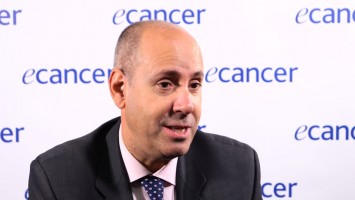Today we presented the overall survival results for the MONALEESA-7 clinical trial. This is a phase III clinical trial that enrolled over 670 women who had hormone receptor positive, HER2 negative metastatic breast cancer. All of the women were pre- or perimenopausal so we were exclusively evaluating a patient population of younger women, women under the age of 59. Patients were eligible if they had not received prior endocrine therapy for metastatic disease; up to one prior line of chemotherapy was allowed for metastatic disease though the minority of patients had received chemotherapy in the metastatic setting. Patients were all treated with an aromatase inhibitor or tamoxifen based on a decision between their doctors and themselves and they were all treated with goserelin to render them postmenopausal. Half of the women received placebo in addition to that endocrine therapy and half received ribociclib.
The primary endpoint of this clinical trial was progression free survival and in 2018 we published the primary endpoint. This study did meet a statistically significant improvement in progression free survival. Ribociclib added to endocrine therapy improved PFS by 10 months. For this reason ribociclib is approved for pre- and perimenopausal women in the US if they have hormone receptor positive metastatic breast cancer.
What we presented here at ASCO is the overall survival results. With about three years of median follow-up we demonstrated a statistically significant improvement with ribociclib added to endocrine therapy for these young women. There was a 29% relative risk reduction in death; at the 42 month landmark analysis 46% of the patients in the placebo arm were still alive compared to 70.2% in the ribociclib arm and this is highly statistically significant, having met our pre-specified endpoint.
So it’s really a great day for women, especially young women, because for the very first time we’ve demonstrated a CDK4/6 inhibitor not only improves our ability to control disease but improves the span of life for women.
Thank you. How can this data influence clinical practice?
I think these data are going to influence clinical practice. It’s very hard to achieve an overall survival statistically significant finding in metastatic breast cancer because patients are able to go on and receive other therapies after they come off clinical trial. Many are able to live for years. So the fact that we have demonstrated that treatment with this agent has a carry-over benefit that actually extends their lifespan is really practice changing. I think it’s going to drive oncologists to pursue the use of this agent even over chemotherapy or single agent endocrine therapy for this type of disease.
How does this outcome compare with postmenopausal women?
This study was specifically looking at women who were younger and who were pre- or perimenopausal when they went on study but our treatment with goserelin rendered these patients postmenopausal. While our patient population was entirely a younger population of patients, biologically these results, there’s no reason they shouldn’t translate into similar results in the postmenopausal setting because these women are chemically rendered postmenopausal.








